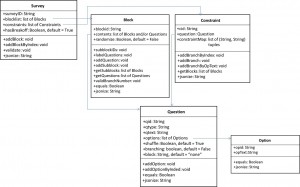My new branching validation seems to be working with the test cases I’ve given it. Everything seems to be working properly, so this week I started working on refactoring the hierarchy of the Python folder and organizing my files. After fiddling around with __init__.py files, I created a new SurveyMan package in the python folder with subpackages survey, examples, and test. All of the files previously contained in the survey directory in the python folder are now in one of the subpackages. The survey package contains the main components for building the survey (the survey_representation and survey_exception modules).
Emma finished writing the JSON validator and a new schema, so I will be testing my current JSON against that this week. She suggested I alter the SurveyMan __init__.py file to include code to copy the contents of the resources folder for testing against the schema. I’m working on writing a script to call the jsonize() method of some of my (correct) survey programs and validate the output against the new schema. Once we figure out what to do about the JSON, assuming no other alterations are needed, I assume I’ll start to think about how to make the SurveyMan package installable.
I added a few updates and refactorings to my design document, as well as a better description of what motivated the design and why the package is necessary. I’ll try to put up a copy later.

